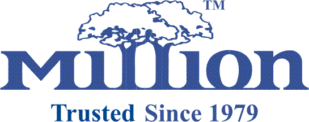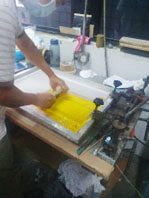Discover Our Guide to Screen Printing on Different Surfaces!
![]() 10 Minutes Read
10 Minutes Read
Introduction
Screen printing, aka silkscreen aka silkscreen printing, dates back at least 100 years. It is said to have first started in China during the Song Dynasty, then adapted by other Asian countries such as Japan, and then introduced to western Europe in the late 18th century. Artists such as Roy Lichtenstein, Andy Warhol, Arthur Okamura and many others have used this method of printing to express their creativity.
丝网印刷方法是指创建模板或单独的丝网,然后使用它在印刷表面上施加额外的油墨层的过程。每种颜色都需要使用不同的模板来应用。为了获得多色图像,打印机将一次应用一种颜色,并使用重复的屏幕来获得最终图像。
The Process
The industrial screen printing process, which is automated, uses advanced inks and materials together with computer technology to conduct mass print. For large volumes of products, it is critical to ensure that the applied layers work perfectly. The commercial screen printing industry uses a wide range of inks for this silkscreen printing method, such as solvent-based inks, water-based inks, plastisol inks, UV-curing inks and special varnishes.
丝网印刷过程的第一步是创建设计。之后,设计将被打印在透明的醋酸纤维薄膜上。下一步是使用设计创建筛网并选择筛网目数,即一平方英寸内的纤维总数。您需要的网格数取决于设计。更高的网格数意味着您可以打印更精细的设计。
After the screen mesh has been selected, the silkscreen printer will coat it with a light-reactive emulsion layer such as diazo or dual-cure emulsions. He will then place the transparent acetate film with the design on the screen mesh under a bright ultraviolet UV light, and the emulsion will harden and develop after some time. It is important to use separate screens for multiple different colours.
屏幕曝光一段时间后,未覆盖的区域会变硬,未硬化的区域会被冲洗掉,露出清晰的印记。在这个阶段,丝网将被干燥,丝网印刷机将对其进行润色以匹配原始设计。
The next step involves the preparation for print, where the material to be printed is placed below the screen. The silkscreen printer will now pour the desired colour ink to the top of the screen, spreading it across with a squeegee or rubber blade evenly to force the ink past the threads of the silk mesh. If any specific areas are left empty, the ink will set there and transfers onto the material, hence printing the design on the product, which will be heat-cured by passing it through a dryer to ensure that it is fade-proof. The mesh can also be washed and then used to create new stencils or screens.
工业丝网印刷机通常使用不同种类的丝网印刷机,但这些是最常见的类型——平板式、滚筒式和旋转式。大多数现代商业印刷机将使用自动旋转轮转印刷机,因为这允许他们同时使用许多不同的屏幕。
Types of Silkscreen Printing
丝网印刷工艺总共有六种主要类型,它们会产生截然不同的结果,因此了解它们很重要。
专色丝网印刷
Spot colour screen printing is the most common silkscreen printing process which uses the ink’s stock colour by printing it through the screen of the mesh. Advantages of this method is that it produces a vibrant spot colour and is a simpler technique as compared to other silkscreen printing methods. This method is often used for printing on garments such as t-shirts and jackets. (See Tips for creating beautiful and effective design that makes the most of spot colors)
半色调丝网印刷
渐变中的单一颜色以半色调丝网印刷方式印刷,该印刷使用一种变成半色调的单一油墨颜色——从远处观察时会出现不同的阴影。这是一种经济有效的方法,因为只使用一种颜色。此过程最常用于在不实际打印的情况下获得多色打印外观。
灰度丝网印刷
作为最具成本效益的丝网印刷方法之一,灰度印刷涉及将全彩色图像印刷为一种颜色的灰度或半色调,并且通常用于将黑白设计印刷到织物上。
双色丝网印刷
Similar to the sepia-toned printing technique in photography, duotone screen printing combines two halftones to print the same image with two colours. A black halftone is first printed with black ink, and then a second halftone is printed with colour ink. The final output is sophisticated and refined.
CMYK丝网印刷
Considered as the most complicated screen printing methods out there, CMYK silkscreen printing uses the four basic colours – cyan (C), magenta (M), yellow (Y) and black (K) to produce the necessary colour tones.
模拟丝网印刷
A versatile silkscreen printing method as it can be used for both lighter and darker shades of materials, the simulated silkscreen printing process combines the CMYK silkscreen printing technique with the spot colour silkscreen printing process. Businesses love to use this process, as it can be used to produce photorealistic print details.
Can You Use Silkscreen Printing on Any Surfaces?
A silkscreen print is most commonly used for paper and fabric printing, such as for custom t-shirts like polo t-shirts and hoodies. However, silkscreen printing can also be used for custom designs on other materials and surfaces such as plastic, wood, metal and even glass and ceramics.
一些使用丝网印刷方法的行业包括工业制造、面板制造商和系统集成商,以及工程、采购和施工。这些行业经常在标识产品和标签需求上使用丝网印刷,例如塑料产品,脚手架标签, 消防设备位置标志, 交通标志, 设施标志,以及图形覆盖,如控制面板。
Other examples of silkscreen print products where silkscreen printing are used include decals, labels and signs, as well as corporate gifts such as clocks and watch faces, plaques and shields, balloons, pens and so on.
Advantages of Using Silkscreen Printing
Silkscreen printing is a popular method of printing in industrial printing as there are many benefits.
Cost-Effective
Silkscreen printing is a fairly simple process and large runs of the same graphics can often be printed together economically, as compared to digital processes. It allows the printer to create a stencil, and then easily reproduce a design from the original image multiple times, as the same stencil can be used. The set-up time only applies in the initial creation of the stencil, and repeated designs can be run quickly and efficiently.
The parts used in the silkscreen method of printing are also easy to replace, and they can withstand wear and tear. Hence, the costs saved can be passed on to the customers.
Durability
Most industrial customers also choose the silkscreen printing method because the final products are more durable and long-lasting, and will not fade or become dull overtime. A silkscreen print lasts longer because of the ink adhesion, where different types of specialty inks are specially formulated to work with individual substrates. Such silkscreen printed inks adhere much more permanently than digital inks to uncoated surfaces. They can withstand more wear and tear too, without losing printed quality.
Excellent Print Quality
A silkscreen print works very well with small text and fine-line illustrations, producing excellent colour prints, especially on colour logo printing and complex designs. Gone are the days when you view sharp and vibrant graphic designs on your computer, only to find them lacking in quality when they are actually manufactured. Such incidents will not happen with silkscreen print products.
Silkscreen printing is also the only printing method that can achieve a texturised, three-dimensional look and feel in your finished design.
Ability to Use Bolder Colours and Designs
The silkscreen printing method allows you to use thicker inks, and hence, your design team can play with bolder colours and designs, which will produce fantastic finishes with far more intense and vibrant colours and sharpness than the CMYK-style dots of solid colours used in digital printing.
Customers looking to increase their brand awareness in signages and other outdoor communications materials can opt for the silk screen printing method, because it will greatly increase your brand visibility.
多功能性
丝网印刷比其他传统印刷技术更通用,因为表面不必在压力下印刷,例如 蚀刻,也不必是平面的或平面的。此外,正如我们上面提到的,您可以使用不同的墨水来处理各种材料,例如木材、金属、玻璃和塑料。
丝网印刷方法也适用于不寻常的形状,例如工业制造领域中具有大型和/或高调物体的特殊零件。
Disadvantages of Using Silkscreen Printing
The silkscreen printing technique has more advantages, but there are also some disadvantages. Under certain circumstances, silkscreen printing can be costly. For example, if your quantity is small, it can be costly. The cost can also increase if your designs are very colourful, or need gradients.
要了解有关丝网印刷或我们不同类型的丝网印刷服务的更多信息,请联系我们。
了解更多
Processes
- Discover Our Guide to Screen Printing on Different Surfaces!
- Maximize Your Digital & Screen Printing Results
- Create Professional Print-Ready Files Easily: Solve Your Printing Woes Now!
- Which printing method offer the better colour fastness, Digital or Screen Print?
Standards
- Get to Know the Weathering Test Standard Test Procedure now!
- What is Corrosion artificial atmosphere-salt spray test?
一般事务
- Get your Free Guide: Choose the Right Sign Material
- 8 Tips to Stop Discoloration of Outdoor Surfaces Now!
- The Science behind why red fades faster than white
- Get the best deals by getting directly from the manufacturer
- Save More Money Now: Don’t Get Stuck Paying More for Less
- What you need to know about ink adhesion: why it matters

